Human Orbital Spaceflights
![]()
International Flight No. 157STS-55Columbia (14)55th Space Shuttle missionUSA |
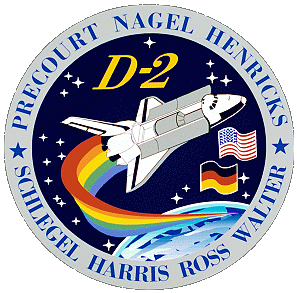 |
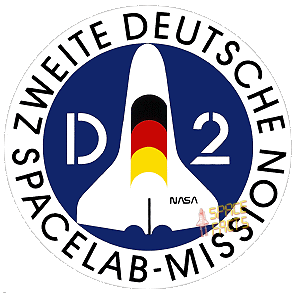 |
![]()
Launch, orbit and landing data
walkout photo |
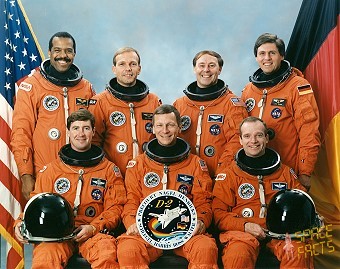 |
|||||||||||||||||||||||||||||
alternative crew photo |
alternative crew photo |
|||||||||||||||||||||||||||||
alternative crew photo |
||||||||||||||||||||||||||||||
alternative crew photo |
||||||||||||||||||||||||||||||
Crew
| No. | Surname | Given names | Position | Flight No. | Duration | Orbits | |
| 1 | Nagel | Steven Ray | CDR | 4 | 9d 23h 39m 59s | 160 | |
| 2 | Henricks | Terence Thomas | PLT, IV-1 | 2 | 9d 23h 39m 59s | 160 | |
| 3 | Ross | Jerry Lynn | MS-1, PLC, EV-1 | 4 | 9d 23h 39m 59s | 160 | |
| 4 | Precourt | Charles Joseph | MS-2, FE | 1 | 9d 23h 39m 59s | 160 | |
| 5 | Harris | Bernard Anthony, Jr. | MS-3, EV-2 | 1 | 9d 23h 39m 59s | 160 | |
| 6 | Walter | Ulrich Hans | PS-1 | 1 | 9d 23h 39m 59s | 160 | |
| 7 | Schlegel | Hans Wilhelm | PS-2 | 1 | 9d 23h 39m 59s | 160 |
Crew seating arrangement
|
 |
|
||||||||||||||||||||||||||||||||
Backup Crew
|
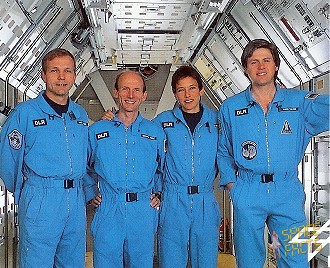 |
|||||||||||||||
alternative crew photo |
||||||||||||||||
alternative crew photo |
Hardware
| Orbiter : | OV-102 (14.) |
| SSME (1 / 2 / 3): | 2031 (8.) / 2109 (10.) / 2029 (7.) |
| SRB: | BI-057 / RSRM 30W |
| ET: | ET-56 (LWT-49) |
| OMS Pod: | Left Pod 05 (3.) / Right Pod 05 (3.) |
| FWD RCS Pod: | FRC 2 (14.) |
| RMS: | - |
| EMU: | EMU No. 2016 (PLSS No. 1015) / EMU No. 2013 (PLSS No. 1005) |
Flight
|
Launch from Cape Canaveral (KSC) and
landing on the Edwards
AFB, Runway 22.
Columbia was initially scheduled to launch in late February however this date slipped to early March due to concerns with the tip-seal retainers in the main engines' oxidizer turbo pumps. All three turbo pumps were replaced at the pad but later inspection revealed the retainers to be in good condition. The launch attempt on March 22, 1993 was aborted automatically at T-3 seconds when computers detected an incomplete ignition of the number three SSME. This was only the third Redundance Set Launch Sequencer (RSLS) Abort after STS-41D and STS-51F. The problem was traced to a leak in the liquid oxygen preburner check valve. All three SSMEs were replaced as a precaution. Another launch attempt on April 24, 1993 was scrubbed due to a possible faulty reading with one of the inertial measurement units. Columbia carried to orbit the second reusable German Spacelab on the STS-55 mission and demonstrated the shuttle's ability for international cooperation, exploration, and scientific research in space. The Spacelab Module and an exterior experiment support structure contained in Columbia’s payload bay comprised the Spacelab D-2 payload. The first German Spacelab flight D-1 flew as Shuttle mission STS-61A in October 1985. The U.S. and Germany gained valuable experience for future space station operations. The D-2 mission, as it was commonly called, augmented the German microgravity research program started by the D-1 mission. The German Aerospace Research Establishment (DLR) had been tasked by the German Space Agency (DARA) to conduct the second mission. DLR, NASA, the European Space Agency (ESA), and agencies in France and Japan contributed to D-2's scientific program. Eleven nations participated in the experiments. Of the 88 experiments conducted on the D-2 mission, four were sponsored by NASA. The crew worked in two shifts (Blue Team: Steven Nagel, Thomas Henricks, Jerry Ross, Ulrich Walter; Red Team: Charles Precourt, Bernard Harris, Hans Schlegel) around-the-clock to complete investigations into the areas of fluid physics, materials sciences, life sciences, biological sciences, technology, Earth observations, atmospheric physics, and astronomy. Many of the experiments advanced the research of the D-1 mission by conducting similar tests, using upgraded processing hardware, or implementing methods that take full advantage of the technical advancements since 1985. The D-2 mission also contained several new experiments which were not previously flown on the D-1 mission. The D-2 Mission conducted 88 experiments to study life sciences, material sciences, technology applications, Earth observations, astronomy, and atmospheric physics. Material Sciences Experiment Double Rack for Experiment Modules and Apparatus (MEDEA) MEDEA was located in rack 3 of the Spacelab module and accommodates three different experiment furnace facilities. These furnaces were the Elliptical Mirror Furnace (ELLI), the Gradient Furnace (GFQ) and the High Precision Thermostat (HPT). The Elliptical Mirror Furnace was used for long-term crystallization experiments performed in microgravity. Crystal growth was established by moving the sample along the main axis of the furnace traversing the focus. The Gradient Furnace studied material processing in microgravity by direct solidification methods using metallic crystals grown at high temperatures. The High Precision Thermostat investigated critical phenomena of metals under precisely controlled temperature conditions. Located in rack 8, Werkstofflabor (WL) Material Sciences Laboratory consisted of five furnaces, a fluid physics module and a crystal growth module. The experiments studied several areas of metal processing, crystal growth for electronics applications, fluid boundary surfaces and transport phenomena. Isothermal Heating Facility (IHF) was a high temperature furnace used to process metal samples that investigate a variety of topics. Heater Facility, Turbine Blade Facility (HFT) was designed for processing special metallic alloys. The samples were processed and solidified under microgravity conditions and cast into the shape of turbine blades. Gradient Heating Facility (GHF) provided the necessary heating and cooling for experiments investigating crystal growth, melting solidification and eutetics. Advanced Fluid Physics Module (AFPM) was a multipurpose facility designed to enable investigations on the behavior of fluids in a microgravity environment. AFPM was an improved version of units flown on Spacelab 1 (STS-9) in 1983 and D1 (STS-61A) in 1985. High Temperature Thermostat (HTT and HTS), which consisted of two identical furnaces, were developed to study diffusion processes in liquid metals under microgravity conditions. Cryostat (CRY) attempted to grow high-quality crystals of biochemical macromolecules by diffusion of protein into corresponding saline solutions. The Holographic Optics Laboratory (HOLOP) was a multi-user experiment facility where fluid physics experiments were conducted under microgravity conditions. Located in rack 11, the aim of HOLOP was to investigate phenomena such as transient heat transfer, mass transfer, surface convections and particle motion in gatical transparent media through holographic methods. One of the four experiments was a test subject for studying the application of "telescience" techniques for preparation of utilization of space station missions. The Baroreflex (BA) experiment was located in rack 12. This experiment investigated the theory that lightheadedness and a reduction in blood pressures in astronauts upon standing after landing may arise because the normal reflex system regulating blood pressure behaves differently after having adapted to a microgravity environment. The purpose of this experiment was to determine if there are changes in the baroreflex in microgravity and if so, how they contribute to postflight orthostatic hypotension. Although orthostatic hypotension disappears within a few days after flight, it is very important to understand the causes of this condition which affects the health and safety of the astronauts, including the ability to land the Shuttle at the end of the mission. The experiment used the Baroreflex cuff, a silicone rubber cuff which seals around the neck when pressure is applied. The pressure system was controlled by a microprocessor. The crew member wears a rubber neck chamber and electrocardiograph (ECG) electrodes. Pulses of pressure and suction, which mimic natural blood pressure, are applied through the neck chamber and transmitted through the neck to baroreceptors. The heart rate change provoked by each pressure pulse is measured from the ECG. Heart rate changes will be measured before, during and after the spaceflight. ROTEX was a robotic arm that operated within an enclosed workcell in rack 6 of the Spacelab module and used teleoperation from both an on-board work station located in rack 4 and the ground. This precise robotic arm used teleprogramming and artificial intelligence to look at the design, verification and operation of advanced autonomous systems for use in future applications. ROTEX was comprised of: a robot arm with six joints which can reach in all directions to grasp objects, two torque sensors located of the back of the gripper to ensure that the robot arm does not become overloaded, a gripping assembly containing laser distance-measuring devices, tactile sensors and stereo television cameras which give a direct view of the object, two fixed video cameras that provide stereo pictures of the whole assembly. The performance of diverse tasks by space manipulators requires a hierarchically and modularly structured automation concept tunable to the special operational case, which in addition allows human interference on different levels of supervisory and decision control. This in term yields the requirements for the hardware and software concepts to be realized, covering the range from telemanipulation up to a completely autonomous operation. The payload element "Anthrorack", developed for ESA, was designed to investigate human physiology under microgravity conditions. AR provided a set of common user stimulation and measurement instruments, supported by centralized services including power supply, control and data handling. The AR was composed, of the following service elements: Blood Sample Collection Kit, Urine Monitoring System, High Speed Centrifuge, Respiratory Monitoring System, Ergometer, Peripheral Blood Measurement System, Manual Blood Pressure Measurement System, Limb Volume Measurement Device, Electrode Contact Impedance Meter, Ultrasound Monitoring System. The Biolabor was used to perform research in electrofusion of cells, cell cultivation, botany experiments and zoological experiments. The Biolabor facility was a life sciences and biotechnology research device developed by Germany (MBB/Erno) for use in the Shuttle/Spacelab. Biolabor consisted of a cell electrofusion workbench equipped with a microscope, a cell electrofusion control unit, two cell cultivation incubators, a 41 C cooler and two middeck-mounted cooling boxes. The workbench could accommodate a series of experiment-specific test chambers, including chambers to support electrofusion of different protoplasts of plant species and chambers for electrofusion of mammal cells. The workbench microscope allowed observation of the test chambers by the crew and the experimenter via downlinked video. On the D2 mission as part of the Cosmic Radiation Experiments, detectors were worn by the astronauts and placed near the biological experiments as control indicators. They also were placed in the biostacks, which are stacks of trays containing small biological specimens such as plant seeds, insect eggs and bacterial spores, alternating with radiation detectors. The results of these experiments were contributed to the assessment of the biological effects of specific cosmic radiation and so help to reduce the health risks for future human exploration missions. A structure mounted in the Columbia's cargo bay near the module provided support for additional experiment facilities which could be connected to the module for power and data, but which may run independently. The Material Science Autonomous Payload (MAUS) was comprised of two experiments: one explored diffusion phenomena of gas bubbles in salt melts, while the other performed research of complex boiling processes. The Atomic Oxygen Exposure Tray (AOET) was a self-standing facility located on the support structure that performed experiments in the field of material science. The AOET used the orbiter as an exposure laboratory to obtain inside reaction rate measurements for various materials interacting with atomic rate measurements for various materials interaction with atomic oxygen with the low-Earth orbital environment. The Galactic Ultrawide-Angle Schmidt System Camera (GAUSS) was an ultraviolet camera used to provide wide-angle, photographic coverage of the galaxy. Pictures taken of the Milky Way galaxy, younger stars and the gas clouds, which they warm up, extended the knowledge of our galaxy significantly. A number of exposures of the Earth's atmosphere also were planned when the orbiter bay faces the Earth. The GAUSS camera was a mirror system for the ultraviolet with a field of view of 145 degrees. The Modular Optoelectronic Multispectral Stereo Scanner (MOMS) was an advanced camera system for Earth observation. The instrument was located on the USS platform and provided imaging data from space for photogrammetric mapping and thematic mapping applications. The Crew Telesupport Experiment (CTE) combined an onboard computer-based, multi- media documentation file, including text, graphics and photos, with a real-time, graphical communication between the on-orbit crewmember and the ground station. The result of CTE should enhance the effectiveness of the following areas: On-orbit payload operations, Scientific return, Crew to ground interaction, Contingency maintenance tasks for systems and payloads Equipment used for the CTE is the interactive Hypermedia documentation file stored on an optical disk and a Macintosh portable computer equipped with a pen-activated, interactive graphics tablet as a peripheral. Students in the United States and around the world had a chance to speak via amateur radio with astronauts aboard the Space Shuttle Columbia during STS-55 as part of the Shuttle Amateur Radio Experiment (SAREX). There also were voice contacts with the general ham community as time permits. Also during the mission, an antenna test was conducted on orbits 61 and 62 involving many amateur radio stations in the southern U.S. who measured the exact time of acquisition of signal and loss of signal along with other data. Shuttle Commander Steven Nagel (call sign N5RAW), Jerry Ross (N5SCW) and payload specialists Hans Schlegel (DG1KIH) and Ulrich Walter (DG1KIM) talked with students in nine schools in the United States and with students in France, Australia and South Africa using "ham radio". The crew got contact to the MIR space station and spoke with Gennadi Manakov and Aleksandr Poleshchuk. The crew conducted the first intravenous saline solution injection in space as part of an experiment to study the human body's response to direct fluid replacement as a countermeasure for amounts lost during space flight. They also successfully completed an in-flight maintenance procedure for collection of orbiter waste water, which allowed the mission to continue. Due to bad weather at Cape Canaveral the Columbia was diverted to the Edwards AFB. |
Photos / Graphics
 |
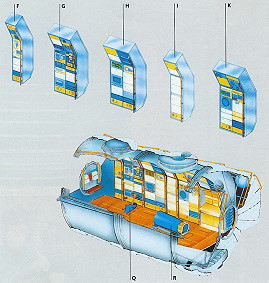 |
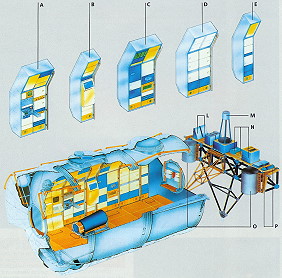 |
 |
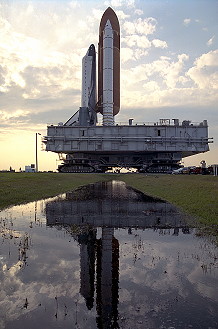 |
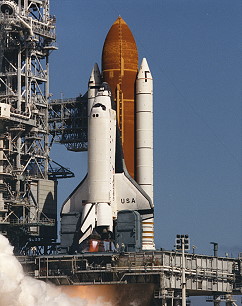 |
 |
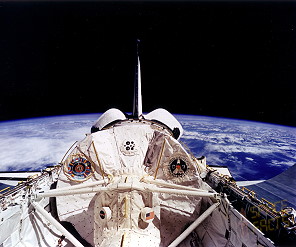 |
 |
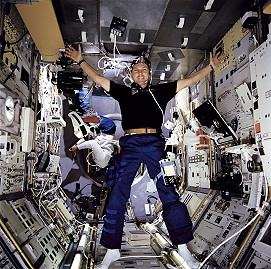 |
 |
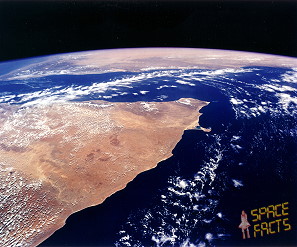 |
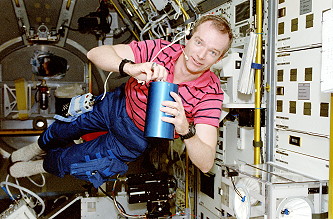 |
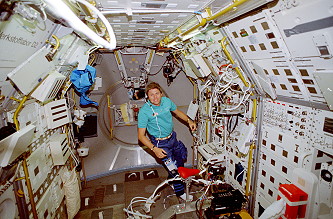 |
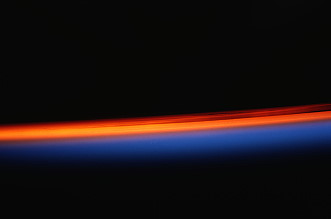 |
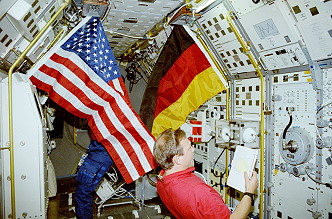 |
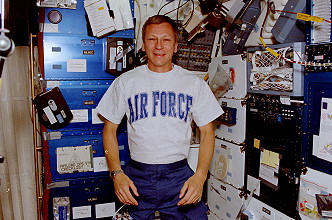 |
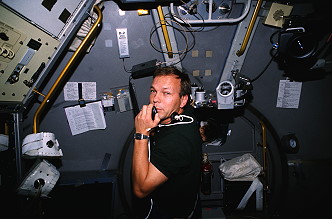 |
 |
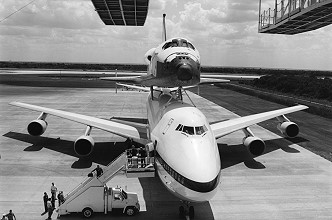 |
more Earth observation photos |
|
| © |  |
Last update on September 10, 2020.  |
 |